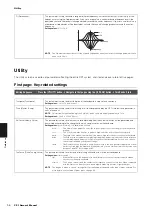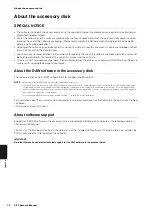
Utility
56
CP1 Owner’s Manual
Reference
Utility
The Utility screen is used to set parameters affecting the entire CP1 system, and it extends over a total of five pages.
First page: Key-related settings
Q (Resonance)
This parameter is used to create a range of different frequency curve characteristics in the vicinity of the
frequency set using the
Freq
parameter. If you set a large value, a narrower band of frequencies will be
boosted or cut, and the tone will change markedly around the center frequency. If you set a smaller value, a
wider band of frequencies will be boosted or cut, and the tone will change gradually around the center
frequency.
Setting values:
0.1 to 12.0
NOTE
The Q parameter cannot be set for the Low and High bands when their respective
Shape
parameters have
been set to “shelv”.
Editing Sequence:
Press the [UTILITY] button
Navigate to first page using the [
L
PAGE] button
Turn Knobs 2 to 6
Trnspose (Transpose)
This parameter is used to adjust the pitch of the keyboard in steps of one semitone.
Setting values:
-12 to +12 (semitones)
Tune (Master Tuning)
This parameter is used to adjust the tuning of all sounds produced by the CP1’s internal tone generator in
units of one cent.
NOTE
This instrument’s default tuning is 440 Hz (A3), and 4 cents are roughly equivalent to 1 Hz.
Setting values:
-102.4 to +102.3 (cents)
VelCurve (Velocity Curve)
This parameter is used to select a curve for determining how the actual velocities will be generated and
transmitted according to the strength with which you play notes on the keyboard.
Setting values:
norm (Normal), soft, hard, wide, or fixed
norm .............The Normal curve produces velocities in direct proportion to the strength of your keyboard
playing.
soft ...............The Soft curve makes it easier to produce high velocities across the entire keyboard.
hard ..............The Hard curve makes it more difficult to produce high velocities across the entire keyboard.
wide..............The Wide curve accentuates your playing strength by producing lower velocities in response
to softer playing and louder velocities in response to harder playing. As such, you can use
this setting to expand your dynamic range.
fixed .............The Fixed curve can be used to sent a fixed velocity to the tone generator regardless of how
hard or soft you play the keyboard. When selected, you can set the actual velocity to be sent
between 1 and 127 by turning Knob 5.
TunCurve (Piano Tuning Curve)
This parameter is used to select one of two tuning characteristics for the entire keyboard.
Setting values:
flat or stretch
flat ................With the Flat curve, the frequency (in Hertz) doubles for each octave increment between
keys across the entire keyboard.
stretch ..........The Stretch curve models the characteristic response of an acoustic piano. When compared
with the Flat curve, lower keys are tuned slightly flatter; higher keys, slightly sharper.
NOTE
The degree to which a “stretch” setting affects actual tuning will depend on the type of piano selected. For
more details, see the table of piano types on page 43.
–
+
0
0.1
12.0
Frequency
Frequency






























